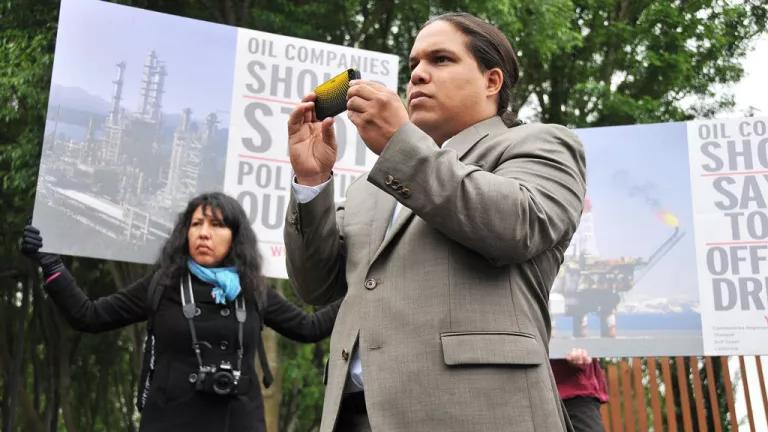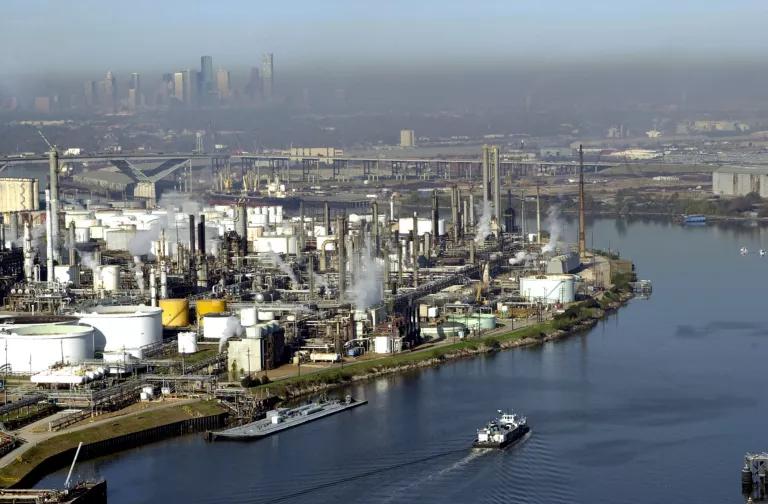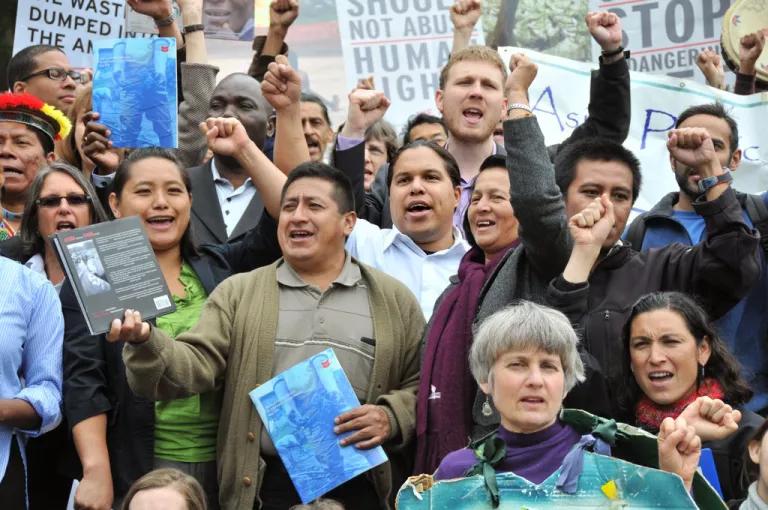Environmental Justice: One Texas Man’s Refinery Fight
For activist Bryan Parras, a native of Houston’s refinery-filled east side, the personal is very much the political.

Bryan Parras documenting protesters at a press conference
One day earlier this summer, as the temperature climbed into the mid-90s and the humidity rose to match it, Bryan Parras decided to go for a run.
A run between Houston and New Orleans.
He’s not crazy—he had a good reason. Participating in one leg of the Peace & Dignity Journeys run, Parras and a dozen or so others passed the baton to one another, relay-style, collectively covering between 50 and 100 miles a day. The goal of the event was to bring together (in the words of its organizers) thousands of “native and nonnative individuals who are strongly committed to the preservation of Native American culture,” all in a spirit of sacred purposefulness.
For Parras, a Mexican-American native of Houston’s refinery-heavy east side, the experience also represented another opportunity to do what he’s been doing his entire adult life: drawing attention to issues of environmental justice, specifically how communities of color are adversely affected by their proximity to some of our nation’s most toxic oil-refining and chemical-processing facilities. According to a prophecy shared by a number of indigenous cultures, he says, the first 500 years of colonization by Europeans would be “marked by chaos and by the dominance of a fast-paced, mechanized, industrialized way of thinking.” But at the end of this 500-year period, he says, the prophecy predicts that indigenous peoples throughout the Americas will come together to correct this spiritual imbalance, “allowing for a new era of higher consciousness and for new ways of life that are more in balance with nature.” The run, Parras and others believe, was an expression of this new era’s dawning.
Parras was born in 1977, “the same year that Exxon discovered climate change was a reality, and the same year they started lying about it,” he says. In 1998, with his father, the activist and organizer Juan Parras, he cofounded Texas Environmental Justice Advocacy Services (TEJAS), a Houston-based environmental justice advocacy organization that aims “to promote environmental protection through education, policy development, community awareness, and legal action.” Through partnerships and campaigns, TEJAS is committed to improving air quality and reducing chemical exposure for members of Houston’s fence-line communities: neighborhoods next to oil refineries, chemical plants, and industrial waste sites, where pollutants consistently threaten the health of residents who typically lack the political power to improve conditions on their own.

One such fence-line community in Houston is Manchester, a neighborhood so dangerously polluted that living there has been likened to “sitting in traffic 24-7.” For journalists, politicians, and other interested parties, Parras and his father have led numerous “toxic tours” through Manchester and adjacent neighborhoods all up and down the Houston Ship Channel, the 50-mile-long conduit that supports not only the bustling Port of Houston but also one of the largest petrochemical complexes on the planet. These tours are meant to highlight a fact that many industry figures and politicians would prefer not to have highlighted: that people—most of them black or brown, and many of them poor—actually live next to all of this infrastructure.
Until last year, the fate of Keystone XL pipeline was a primary focus for Parras and many of his fellow Houston-based environmental activists. Had it been approved, the completed pipeline would have carried dirty tar sands oil from Canada to Nebraska, where it would have connected with existing infrastructure to send this oil to its terminus at the Houston Ship Channel. For many who care about curbing climate change and promoting clean energy, Keystone XL was a symbol; when President Obama announced in November 2015 that his administration would be rejecting the proposed pipeline, it was a victory for an entire movement galvanized around the idea of spurning petrochemicals for clean energy sources.

But for Parras and other residents of Houston’s fence-line communities, the victory was a qualified one. While stopping one portion of the Keystone pipeline from being built was a triumph, he says, “there’s no victory unless we can stop this stuff at its source,” by which he means that the problem goes well beyond how we transport oil and implicates our entire system of extraction, production, and consumption. “The transport of it wouldn’t be an issue—wouldn’t even matter—if we could [address] that.” He notes with melancholy that far less national attention is being paid to the construction of the Houston lateral pipeline and tank terminal, both of which are scheduled to go online in 2017. When completed, the new terminal is expected to have an initial storage capacity of 700,000 barrels of crude.
Recently, Parras’s advocacy work took him to the town of Eagle Pass, Texas, just across the border from the city of Piedras Negras in the Mexican state of Coahuila. There he interviewed local residents about the significant air and water pollution generated by a 6,000-acre open-pit coal mine on the U.S. side of the border. The low-quality coal taken from the ground there is too dirty to be burned in our country under current regulations—but not too dirty to be burned just a few miles away in Mexico. For the past year, residents of Eagle Pass have been trying to draw attention to the mine’s massive pollution, which they say puts it in clear violation of the U.S. Environmental Protection Agency’s U.S.–Mexico Border 2020 Program.
The video testimonies of Eagle Pass residents speak to the ways in which environmental justice fuses the micro and the macro, the personal and the political. As he prepared himself physically, mentally, and spiritually for the Peace & Dignity run, Parras was inspired to reflect on this relationship. “For me, it’s impossible to separate them,” he says. He and his fellow Peace & Dignity runners “are praying for the well-being not just of ourselves and our families, but of the planet. We’re honoring every living entity. We see the entire system as interconnected; we’re not ‘apart’ from anything else. We can’t just take whatever we want and manipulate the landscape however we choose. And if we continue to think that man can simply create some sort of a hack to fix our way of life as it is now, we’re mistaken.”
Follow Bryan Parras on Twitter @HighTechAztec.
This NRDC.org story is available for online republication by news media outlets or nonprofits under these conditions: The writer(s) must be credited with a byline; you must note prominently that the story was originally published by NRDC.org and link to the original; the story cannot be edited (beyond simple things such as grammar); you can’t resell the story in any form or grant republishing rights to other outlets; you can’t republish our material wholesale or automatically—you need to select stories individually; you can’t republish the photos or graphics on our site without specific permission; you should drop us a note to let us know when you’ve used one of our stories.


Port Arthur, Texas: American Sacrifice Zone
When You Poison Our Lands, You Poison Us
Water Is Life—from Standing Rock to Oaxaca’s Mixtecan Highlands